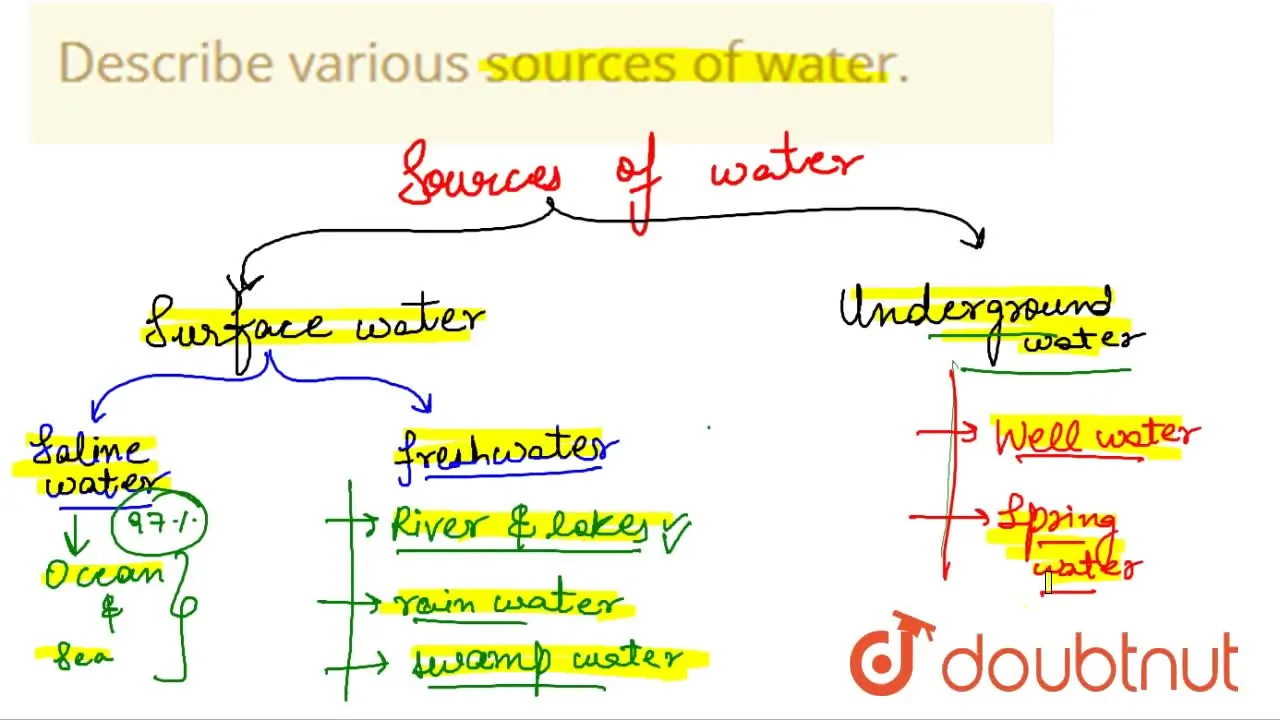Describe various sources of water.
Video Solution
Text Solution
Sources of Water
(a) Surface water: It is the water present on the surface of earth. The water present in oceans, seas, rivers, springs, etc, comes under surface water.
Oceans and Seas: These are the largest sources of water. Almost 97% of water available on earth is present in oceans and seas. This water contains huge amount of dissolved salts in addition to other impurities. Due to the presence of high proportion of dissolved salts (especially 2.5% common salt) which makes the water salty and renders the water unfit for usage and consumption, this water is called saline water.
River and lakes: Rain water from higher altitudes flows down the hills and forms rivers, Apart from this rain water, water formed by melting of ice and snow flows into the rivers. Since water takes a long course and flows over land surface from higher altitudes, it contains various impurities and soluble salts. As the proportion of dissolved salts is less than in saline water, it is considered as fresh water and is available for consumption for various activities.
Rain water: It is the main source of natural water. Since it directly comes from atmosphere, it is the purest form of water. The initial showers of rain water contain dust particles and other microorganisms. The later part of rain water is devoid of any impurities. Therefore it is considered as the purest form of natural water.
(b) Underground water: A part of the rain water reaches the water bodies such as rivers and lakes. A part of the rain water seeps into the soil and reaches the bottom layers. The rain water as well as some water from river water seeps through the soil and fills the empty spaces and cracks in the layers of the earth. This phenomenon is called infiltration and the water is called underground water. As water infiltrates through the open spaces in the soil, it first passes through the zone of aeration where the soil is unsaturated. At greater depths known as recharge area water fills in more spaces until the zone of saturation is reached. At this level, the ground water pressure is equal to the atmospheric pressure and this is known as water table. Below the water table, there is an underground layer of water bearing permeable rock or unconsolidated materials from which ground water can be usefully extracted using a water well. This is called aquifer.
|
Updated on:21/07/2023
Related Playlists
- BOOK - PEARSON IIT JEE FOUNDATIONCHAPTER - WaterEXERCISE - Essay Type Questions8videos
Water
- BOOK - PEARSON IIT JEE FOUNDATIONCHAPTER - WaterEXERCISE - Level-140videos
Water
- BOOK - PEARSON IIT JEE FOUNDATIONCHAPTER - WaterEXERCISE - Very Short-Answer Type Questions22videos
Water
- BOOK - PEARSON IIT JEE FOUNDATIONCHAPTER - MOCK TESTEXERCISE - EXERCISE25videos
MOCK TEST
Similar Questions
Describe various causes of water pollution.
View SolutionDescribe various types of bacteria on the basis of cell shape with examples.
View SolutionDescribe various strategies of heterotrophic nutrition.
View SolutionDescribe various lobes of cerebrum of human brain and their functions.
View SolutionDescribe various categories of dieases.
View SolutionDescribe the various aspects of the presidental elections of 1969.
View SolutionDescribe the various modes of asexual reproduction in the living organisms.
View SolutionDescribe various forms of lipid with a few examples.
View SolutionDescribe various forms of lipid with a few examples.
View SolutionDescribe various steps of cleaning wastewater in a wastewater treatment plant.
View Solution


